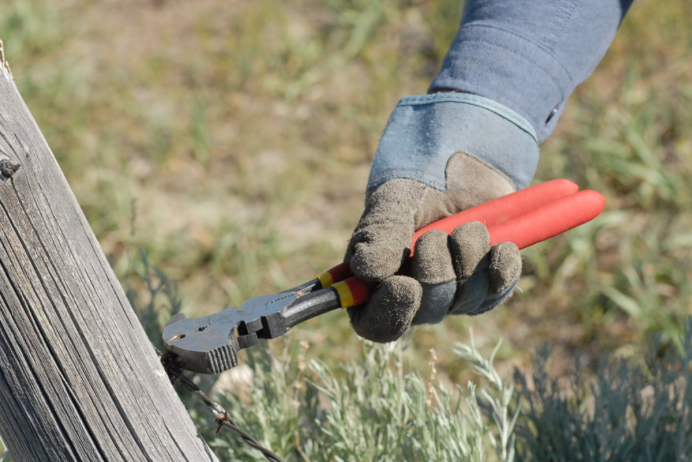
by jhwildlife | May 19, 2017 | Blog, Wildlife Friendlier Landscapes

Please join us Saturday, June 3 at Buffalo Valley Swan Pond, Bridger-Teton National Forest to volunteer to help with the removal of barbed wire and smooth wire fences.
Project Details
For our first public project of the year, we plan to remove .5 miles of barbed wire and smooth wire fencing in prime wildlife habitat in the Buffalo Valley. The work area is scenic and the terrain is flat and easily traversed. This project assists our partners at Bridger-Teton National Forest as they aim to make important habitat more permeable to wildlife movement.
The project is average in difficulty (3 on a 1-10 scale).
We will meet at two car pool sites:
- Home Ranch Parking Lot (north side) at 8:15 a.m.
- Gros Ventre Junction at 8:30 a.m.
We will carpool from these sites to the project. We plan to work from 9 a.m. to 2 p.m. and half-day (morning) is welcome, as well. We will provide water, Gatorade and snacks. Please bring your own water bottle or hydration packs. We will take a mid-day lunch break so please bring your own lunch.
Gear: You should wear layered clothes, long pants, sturdy shoes, and bring a rain jacket in case of storms. Sun or eyeglasses are a MUST for working with barbed wire. Sun protection (hat & sunscreen lotion) is also recommended, and will hopefully be necessary! We also recommend that volunteers check the status of their tetanus shots, in case of scratches from the old fencing material. We will provide work gloves and tools.
Please RSVP to jhwffencepull@gmail.com if you plan to attend and let us know at which car pool site you will join us (1 of 2 locations listed above). You can also send questions to this same email address. Additional last-minute information on this event will be posted here.
See you on June 3!
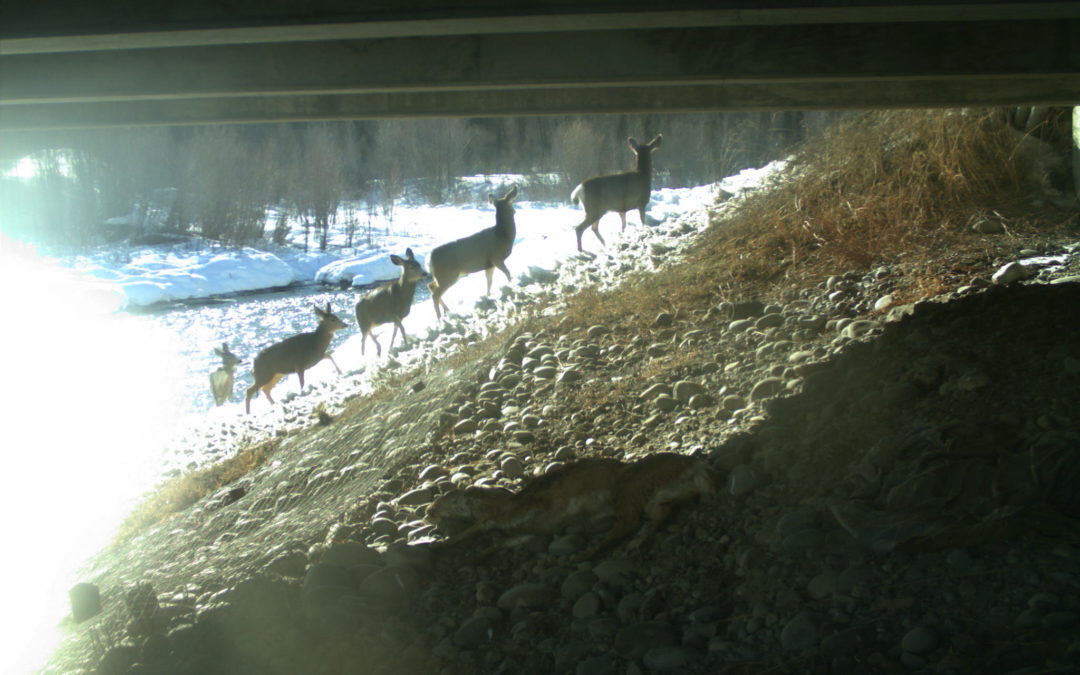
by jhwildlife | May 10, 2017 | Blog, Give Wildlife a Brake
On Saturday, April 29, representatives from the Greater Yellowstone Coalition, Jackson Hole Conservation Alliance and Jackson Hole Wildlife Foundation joined Wyoming Game & Fish Department (WGFD) Wildlife Biologist Gary Fralick to survey winter deer mortality along Highway 89 south of Jackson. None of the participants could have envisioned witnessing an event that brought the poignancy of the wildlife-vehicle issue into vivid focus, but within minutes of starting the survey, they experienced an emotional interaction with one of this winter’s latest casualties.
Fralick led the targeted survey of a half-mile stretch of South Highway 89 from the Snake River Bridge at Von Gontard’s Landing north to Game Creek Road. As a group of six individuals swept through a cottonwood stand on the east side of the highway, they encountered a mule deer doe laying in the underbrush. As the group approached, the deer struggled mightily to flee but couldn’t get to its feet. Its back legs had clearly been broken in a collision with a car. How long it had been suffering there is anyone’s guess, but with the specter of starvation a certainty for an animal with two broken legs, Fralick acted quickly to humanely put the animal out of its misery.
This encounter really struck home for our participants and for Gary himself. All of our organizations recently attended the Wyoming Wildlife and Roadways Summit in Pinedale, which highlighted the biological and engineering considerations in mitigating the impacts of our roads on wildlife and increasing human safety. But this is the side of wildlife vehicle collisions (WVCs) that often goes unseen and is truly tragic. This prime age class doe deer had made it through the difficult winter we had and would likely have survived and helped the population rebound. We also witnessed a side of WVCs that only WGFD wardens and biologists and Wyoming Department of Transportation (WYDOT) highway patrol have to participate in and that is the always difficult reality of dispatching an animal, along a busy highway, something that really can never become easy, even for these trained professionals.
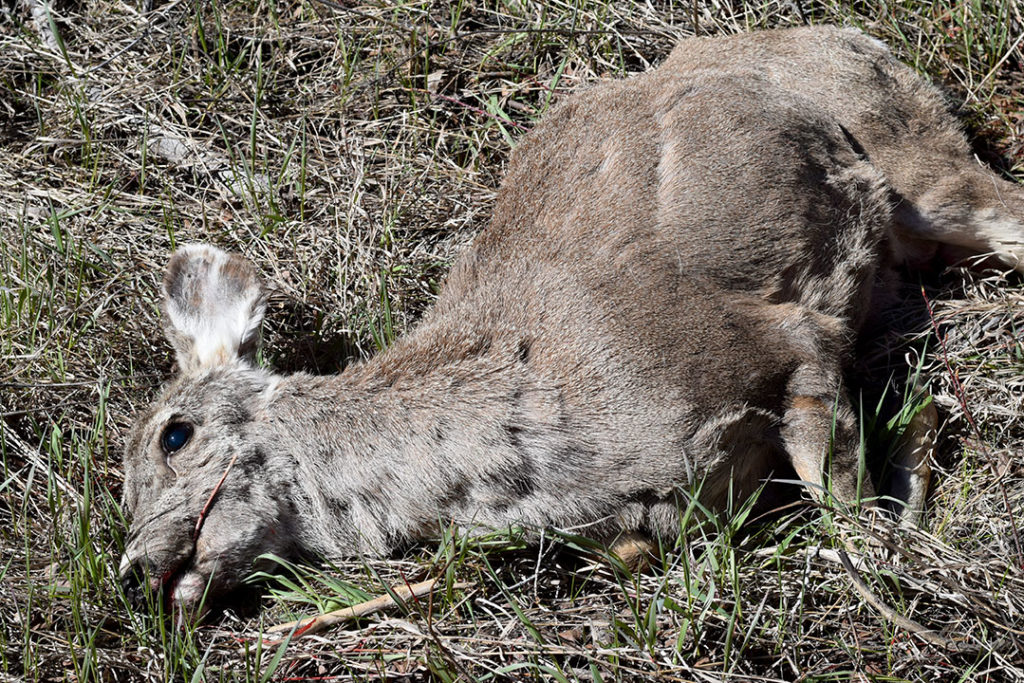
Mule deer doe moments after it was put down.
In reality, the life of that deer ended the moment it was struck by a vehicle. As is often the case, an injured animal struggles to its final resting place well off the shoulder of the road, where it may suffer for weeks until it starves to death. The collision may not have even been reported if it hadn’t caused sufficient damage to the vehicle. Studies have shown that up to one-half of deer vehicle collisions go unreported, so the impacts of wildlife-vehicle collisions are actually far greater than the reports on which we base a lot of our decisions.
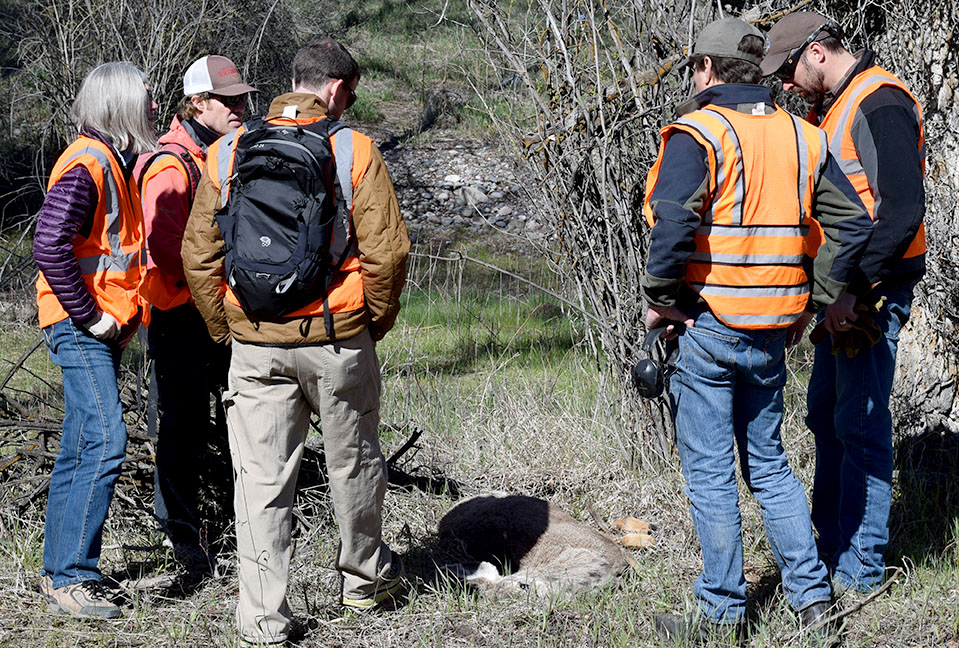
Survey participants, moved by the power of the moment, mourn the loss of a deer that almost made it through a rough winter.
A few hundred yards from that tragic scene, the group encountered a pair of White-tailed deer carcasses that succumbed under the Flat Creek Bridge, likely after having been struck by vehicles. Those two deer, which died weeks apart in February, incidentally had images captured by a remote-sensing camera that had been placed under the bridge to study the movements of wildlife. Watching the prolonged suffering and eventual death of those deer through time-lapse photography is no easier than witnessing it first hand.
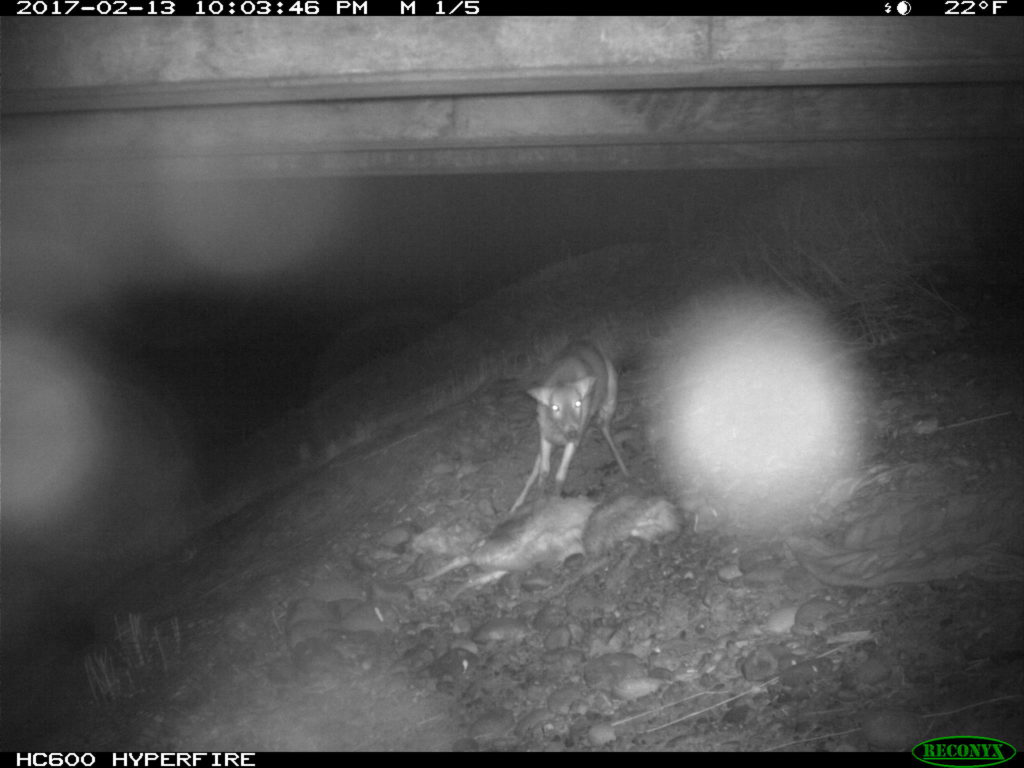
Starting in 2015, several local and regional organizations (Center for Large Landscape Conservation, Greater Yellowstone Coalition, Jackson Hole Wildlife Foundation, Jackson Hole Conservation Alliance, Teton Conservation District and Yellowstone to Yukon Conservation Initiative) began working in collaboration with WYDOT to provide pre-construction monitoring of proposed future wildlife crossings along South Highway 89/191 using remote camera sites at locations identified for their importance for connectivity in a future highway redevelopment project that will begin in 2017.
WYDOT is building six large underpasses and many smaller structures to facilitate wildlife movement, reduce wildlife-vehicle collisions, and improve highway safety. The remote cameras are monitoring the proposed locations.
Those underpasses will facilitate safe passage for deer, elk and moose as well as many smaller animals upon completion. The construction of these structures is starting this summer. Studies suggest underpasses are 80%-90% effective at reducing wildlife-vehicle collisions.
The group conducted the targeted survey to collect data that will contribute to WGFD’s knowledge about the mule deer that winter in and around the town of Jackson. Tooth samples were extracted and fibula marrow assessments were conducted on the spot to ascertain age and relative health, or body condition of the animal when it died. The group surveyed a total of one mile – a half-mile on each side of the highway. Within that stretch, 10 carcasses were observed in the ditches and wooded areas along the road underscoring the impacts of this winter on deer throughout the valley, and WVCs on this stretch of South Highway 89.
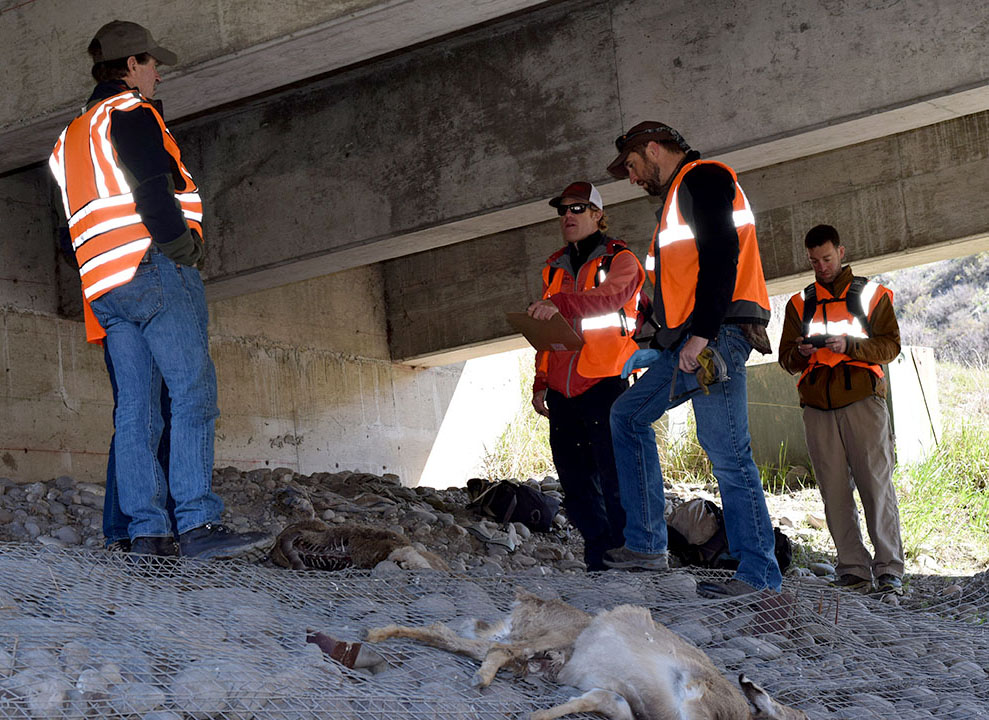
One of the last carcasses we encountered was a very old age-class doe, with a broken hind leg, wearing an eartag. We’re waiting on the results, but the tag likely came from a study looking at local movements and migrations across our roads. During that study, completed by Teton Science Schools, highway collisions was the number one source of mortality for collared deer. Since the collars have fallen off to allow researchers to collect the data stored within them, it is important that this eartag was retrieved and unsurprising that the individual was killed by a car in this stretch of road years after the study was complete.
Thankfully, construction is about to begin on the first series of underpasses on South Highway 89 and much of the carnage the group encountered on its short survey will be reduced or nearly eliminated in the near future on that stretch of highway.
In 2016, WYDOT, WGFD and local citizens recorded a total of 335 wildlife mortalities on Teton County Highways outside of Grand Teton National Park. This trial winter deer mortality survey illuminated the fact that the actual number of mortalities is likely 25%-50% higher, and it also instilled in the participants a reminder that wildlife deaths caused by vehicles often include a long, painful demise out of our view.
As construction begins on some of the first of our wildlife crossing structures in Jackson Hole, we are also grateful that Teton County is looking at its entire network of roads as it completes a wildlife-roadway master plan with the help of experts at Western Transportation Institute. Many organizations and agencies continue to discuss site-specific solutions to eliminate scenes like those witnessed on the winter deer mortality survey. All options are considered with the knowledge that various mitigation measures may be needed to address some of the complexities of Teton County’s land and roadway system.

by jhwildlife | May 2, 2017 | Blog, Wildlife Friendlier Landscapes
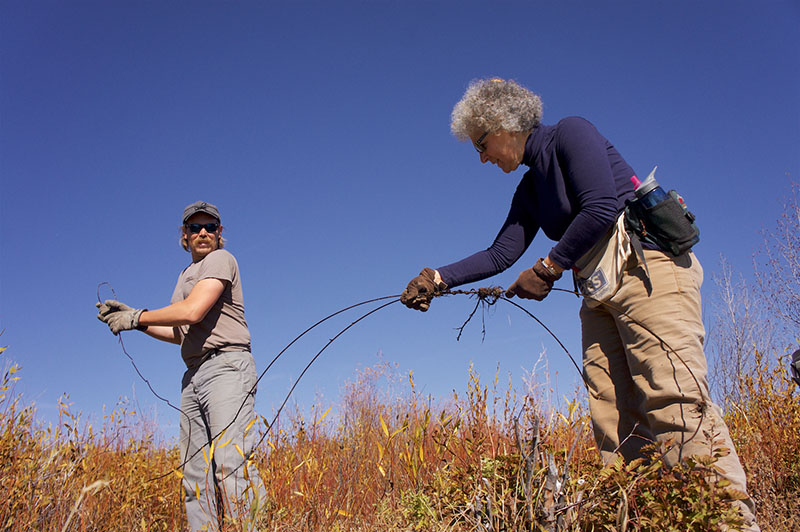
The Jackson Hole Wildlife Foundation has announced dates for its public fence projects in 2017 following its winter and spring of project coordination and site reconnaissance. The Wildlife Friendlier Fencing program reduces dangerous and challenging barriers to wildlife movement.
Public projects offer volunteers the opportunity to contribute to the removal or modification of fences that pose avoidable threats to wildlife while fragmenting vital habitat. JHWF and its “Fence Team” leaders also work on a number of private projects with landowners throughout the summer toward the same end.
Public fence projects typically occur on Saturdays usually from 9am – 2pm with a lunch break. On some projects, half-day “shifts” are available. While listed dates are subject to change or cancellation due to weather and other conditions, JHWF encourages volunteers to save the dates in order to ensure that all can participate as their schedule allows.
JHWF will require an RSVP from each volunteer in advance to ensure that we have the ideal number of volunteers for each project. Interested volunteers receive an email invitation and RSVP request about two weeks prior to the project date with the description, details and other logistics outlined. Please email jhwffencepull@gmail.com or info@jhwildlife.org if you are not currently receiving fence project updates and would like to, or if you have questions about volunteering.
Wildlife Friendlier Fencing Public Project Dates 2017:
- June 3
- June 17
- July 15
- July 29
- August 12
- August 26
- September 16
- September 30 – Public Lands Day
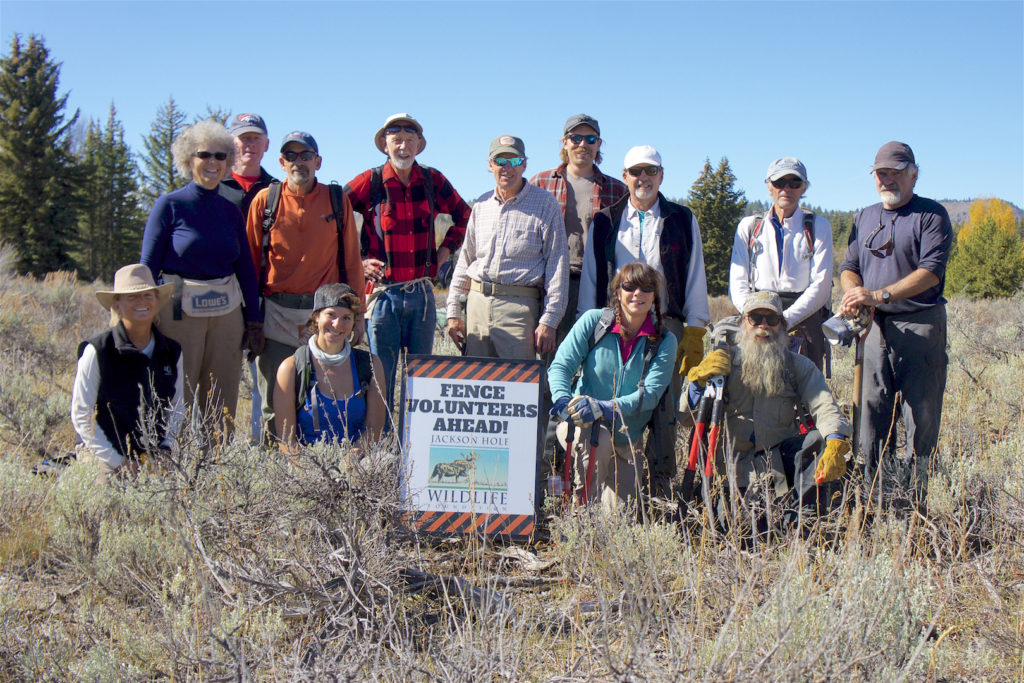
Photo credits: Sava Malachowski

by jhwildlife | Apr 19, 2017 | Blog, Uncategorized
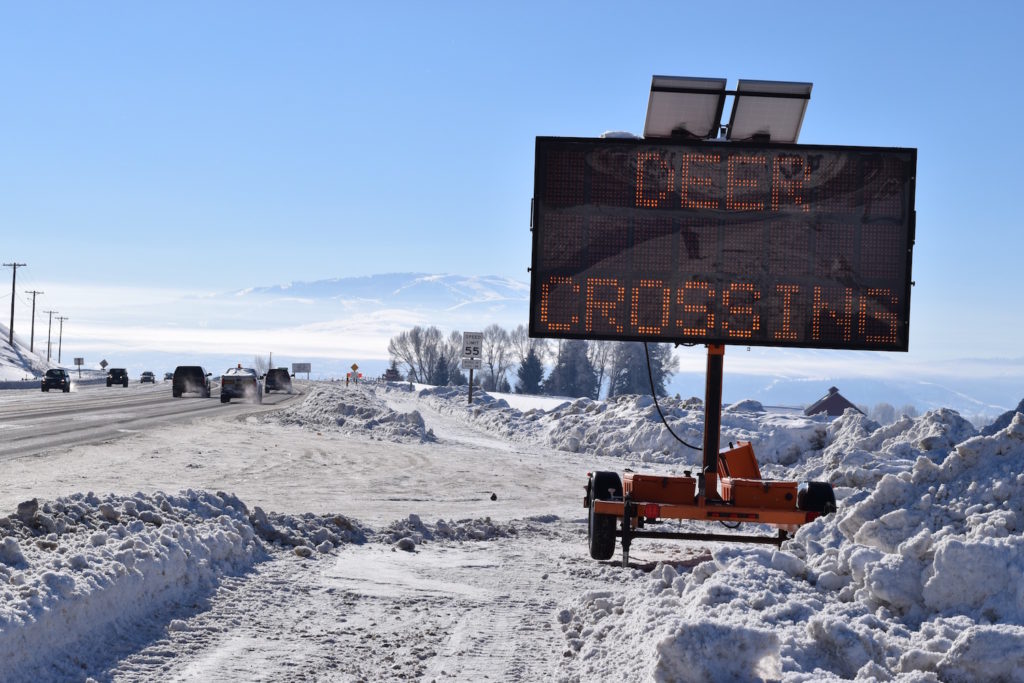
Dear friends of wildlife,
You can help the Wyoming Game & Fish Department (WGFD) and wildlife conservation groups better understand winter mortality of deer by participating in a half-day citizen survey on Saturday, April 29 from 8:30 a.m. – noon. WGFD will lead a carcass survey, along with representatives from Greater Yellowstone Coalition, Jackson Hole Wildlife Foundation, and the Jackson Hole Conservation Alliance, which will include the South Highway 89 corridor from Hoback Junction to the Jackson town limit.
We all know that this past winter has been a bad one for our wildlife. The data we collect will contribute to WGFD and conservation groups management of these wildlife herds. No experience in carcass surveying is needed! Agency professionals from WGFD will show you what to look for and how to conduct routine but important assessments.
We’ll meet at 8:30 a.m. at the Hoback Junction carpool lot near Hoback Market, discuss the day’s plan, the science underlying the survey, and volunteer roles while enjoying donuts and coffee. We’ll do our survey and return around noon. Some folks may gather for lunch thereafter.
Learn about and participate in wildlife science!
Volunteers are encouraged to take part in carcass assessments by extracting teeth and assessing bones with guidance from wildlife professionals. Please bring a stout knife and/or a saw if you’d like to participate in this aspect of the survey.
We will provide: Safety vests, data sheets, rubber gloves for handling carcasses (optional), packets for tooth samples, donuts and coffee, fun!
Volunteer notes
Please dress warm, appropriate for the conditions with boots, layers, sunscreen, etc. and bring a water bottle any other personal essentials in a small backpack.
Each volunteer is free to contribute for as long as they like, covering as much ground as is comfortable. We will break into teams assigned to various sections of different sizes to accommodate everyone. Volunteers will survey land within the highway’s right of way – generally well marked by a fence, but we’ll provide instruction on minimizing any safety risks.
Carpooling is encouraged, so if you do not have transportation or would prefer not to drive, we would still love to have you join us!
If you’d like to join us in this scientific survey, please email Jon Mobeck at jon@jhwildlife.org by Tuesday, April 25 so we can assign territories prior to the survey day.
We look forward to seeing you on April 29!
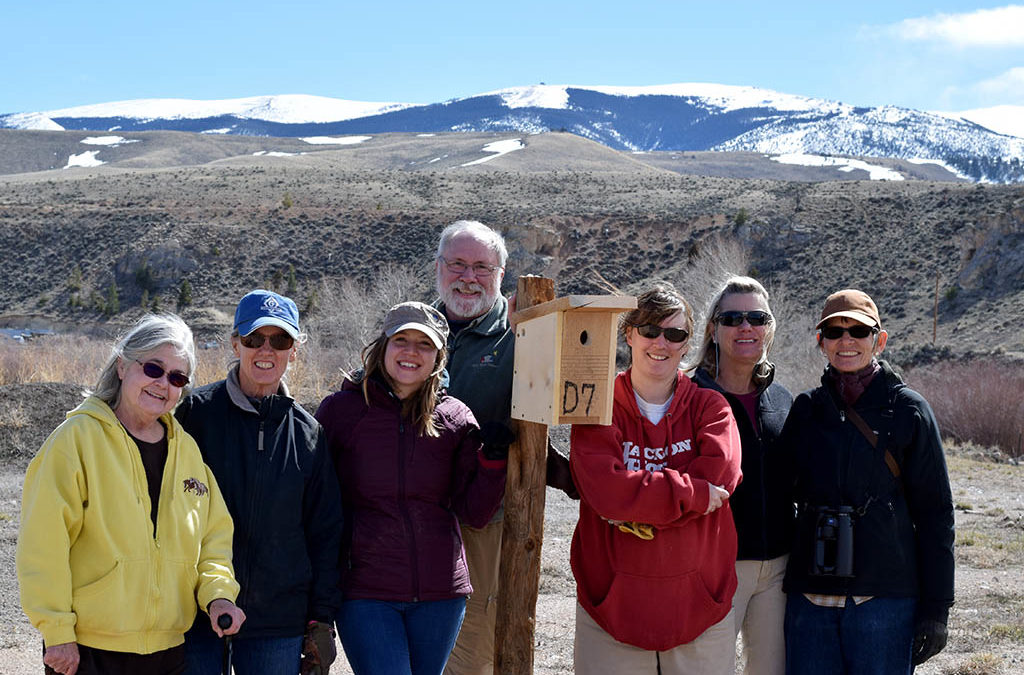
by jhwildlife | Apr 19, 2017 | Blog, Nature Mapping Jackson Hole
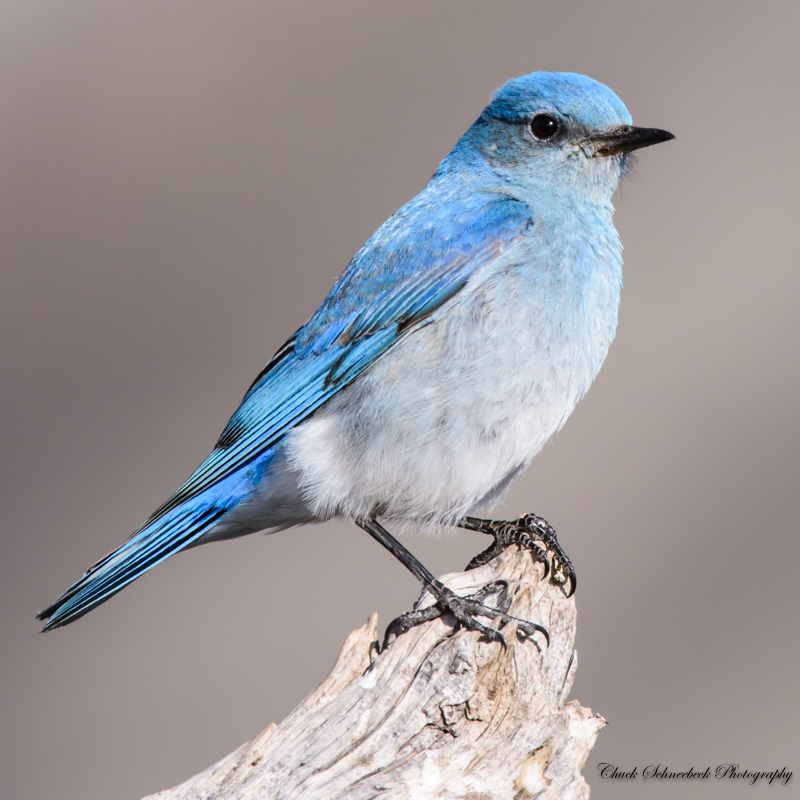
Photo by Chuck Schneebeck
“O bluebird, welcome back again.
Thy azure coat and ruddy vest,
Are hues that April loveth best.”
– John Burroughs
The great writer and conservationist John Burroughs shared his love of the Eastern Bluebird brilliantly, with words that express abiding affection for the “bluebird of happiness.” The resident of our parts, the Mountain Bluebird, has no shortage of admirers uplifted by that bright blue flash across the landscape. Here we are in April, and the Mountain Bluebirds have returned! We see them flitting from post to post along the National Elk Refuge fence, and spiriting their way across the grassy meadows of South Park. After a long winter, could there be a more hopeful harbinger?
At the Jackson Hole Wildlife Foundation, we have the honor of continuing a Mountain Bluebird monitoring program that Chuck and Carol Schneebeck and friends launched more than a decade ago. With the help of dozens of volunteers over the years, we have tracked the number of boxes utilized and by which species, the number of eggs laid, the number of nestlings fledged, and other valuable data to help us understand the lives of bluebirds.
While that data and our growing knowledge of the bluebird is important, perhaps the real power of the program lies in its affect on the people who participate. For anyone who has peered into a box to find a fresh egg or a newly hatched featherless bird, there is no mistaking the thrill of the experience. It can be hard to contain the joyful feeling that John Burroughs described – nearly always shared with others. As we continue to monitor the success of the Mountain Bluebird Nestbox trail along the National Elk Refuge, we’re also exploring ways to share what we’ve experienced with others in neighboring communities. In early April, we had the pleasure of working with a committed group of bluebird enthusiasts in Dubois to install 35 boxes to create the Dubois Community Bluebird Trail. Our super volunteer and bluebird trail expert Tim Griffith provided a trail monitoring orientation to the group at the Dubois Museum. Associate Director Kate Gersh spoke about the success of the nestbox trail in Jackson and why Jackson Hole Wildlife Foundation is interested in partnering with Dubois in a similar effort.
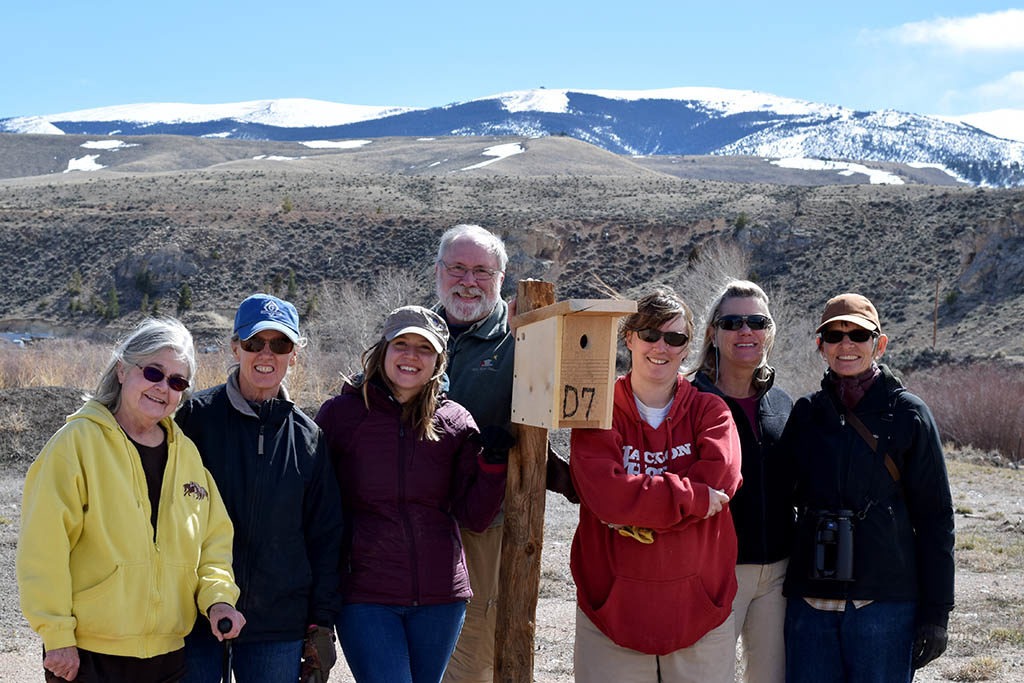
Andrea, Deb, Kate, Tim, Johanna, Bridget and Susan install a box at the Warm Valley Lodge assisted living center in Dubois.
As Aldo Leopold famously said, “a land ethic … evolves in the minds of a thinking community.” Leopold recognized that such an ethic might emerge in the individual first through observation, and the recording of what one has observed. Through this process, one becomes more aware of what is going on around them. Combining individual observations in a community monitoring program brings people together around a shared appreciation for wildlife. Our hope is that bringing communities together to share their observations and interactions will build stronger connections between stewards of Greater Yellowstone lands. Who better than the bluebird to act as that joyful ambassador?

Lead project coordinator Johanna Thompson of the Dubois Museum & Wind River Historical Center makes a Dubois box “official.”
The Mountain Bluebird Nestbox Trail monitoring effort is one of many projects of Nature Mapping Jackson Hole. Each project is designed to increase our local knowledge of many species while advancing our community’s land ethic. Expanding the boundaries of that community might help ensure that our area’s ecosystem is preserved and protected in perpetuity, joining people and lands around common values.
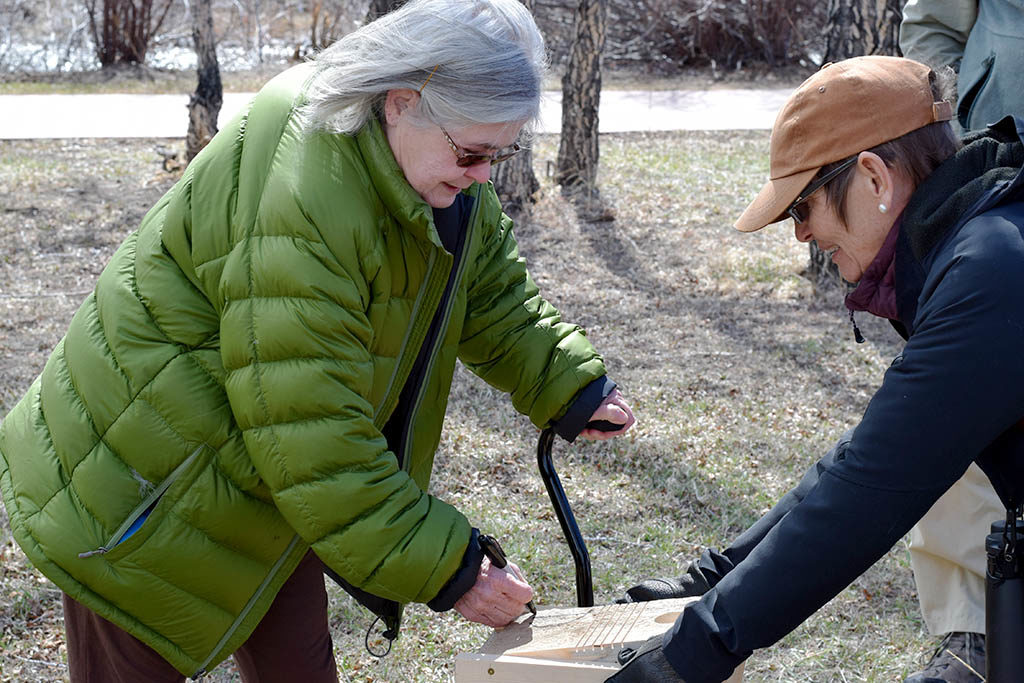
Key volunteer Andrea Billingsley inscribes “D1” on the first box of the Dubois Community Bluebird Trail while Susan Hill supports and celebrates.
View a full gallery of fun images from “Bluebird Day” in Dubois.
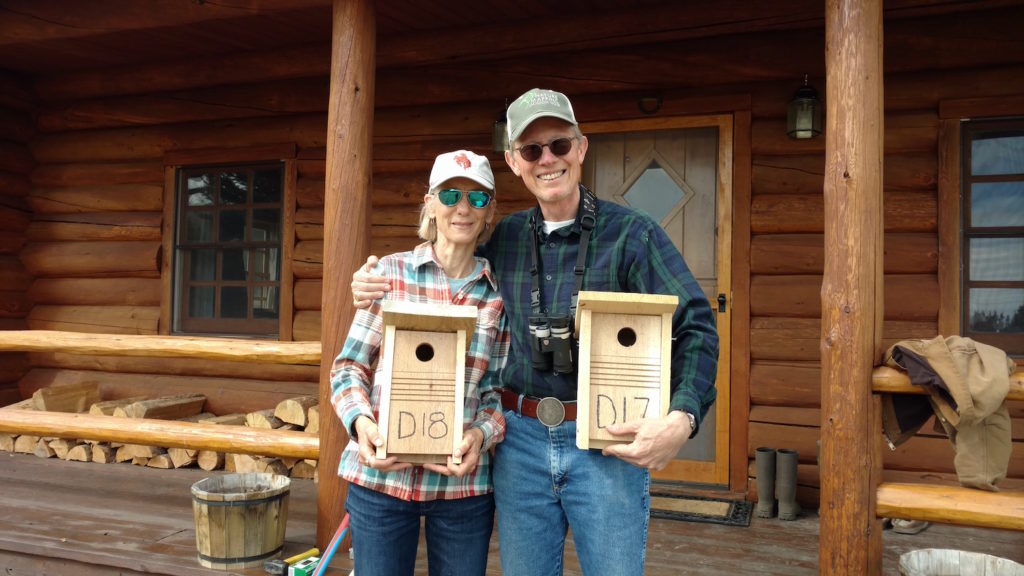
Nancy and Blair Butterfield prepare to install two boxes on their Dubois property with assistance from Jackson Hole Wildlife Foundation staff.


















